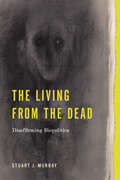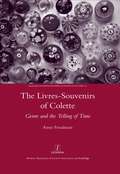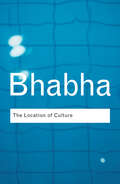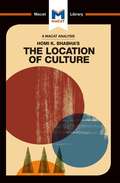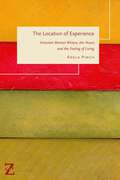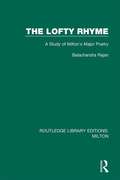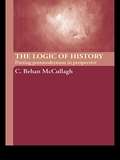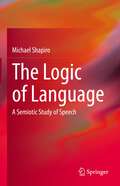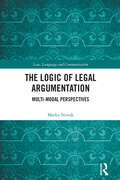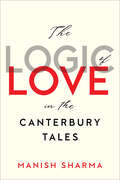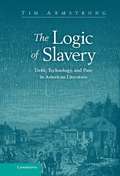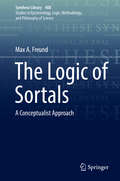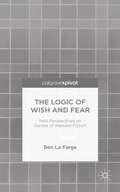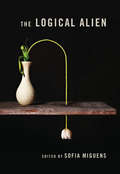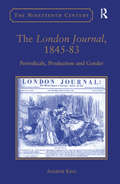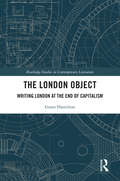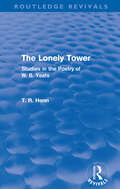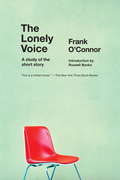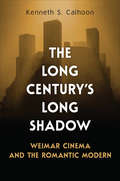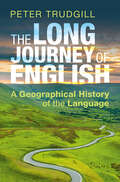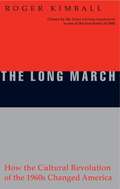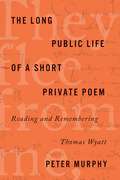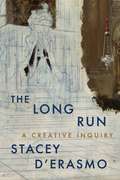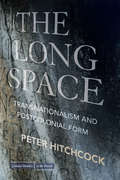- Table View
- List View
The Living from the Dead: Disaffirming Biopolitics (RSA Series in Transdisciplinary Rhetoric)
by Stuart J. MurrayIn a society that aims above all to safeguard life, how might we reckon with ethical responsibility when we are complicit in sacrificial economies that produce and tolerate death as a necessity of life?Arguing that biopower can be fully exposed only through an analysis of those whom society has “let die,” Stuart J. Murray employs a series of transdisciplinary case studies to uncover the structural and rhetorical conditions through which biopower works. These case studies include the concept of “sacrifice” in the “war” against COVID-19, where emergent cultures of pandemic “resistance” are explored alongside suicide bombings and military suicides; the California mass hunger strikes of 2013; legal cases involving “preventable” and “untimely” childhood deaths, exposing the irreconcilable claims of anti-vaxxers and Indigenous peoples; and the videorecording of the death of a disabled Black man. Murray demonstrates that active resistance to biopower inevitably reproduces tropes of “making live” and “letting die.” His counter to this fact is a critical stance of disaffirmation, one in which death disrupts the politics of life itself.A philosophically nuanced critique of biopower, The Living from the Dead is a meditation on life, death, power, language, and control in the twenty-first century. It will appeal to students and scholars of rhetoric, philosophy, and critical theory.
The Livres-souvenirs of Colette: Genre and the Telling of Time
by Anne FreadmanThroughout her career, Colette experimented with genre for the purposes of telling stories of her life. The books that resulted, known collectively as her 'livres-souvenirs', are far from being autobiographies in the customary sense. By addressing the need to reconsider the generic issues surrounding autobiographical story-telling, Anne Freadman's study brings the richness of 'the genre question' to the fore, shedding a fresh light on this much-loved body of work. From the vignettes ofLa Maison de Claudineto the note-books ofL'etoile vesper andLe Fanal bleu, from stories of losing to stories of collecting, Colette's memory books take different narrative forms and explore the passing of time in different ways. This book investigates Colette's variegated generic choices as so many ways of 'telling time'.
The Location of Culture
by Homi K. BhabhaRethinking questions of identity, social agency and national affiliation, Bhabha provides a working, if controversial, theory of cultural hybridity - one that goes far beyond previous attempts by others. In The Location of Culture, he uses concepts such as mimicry, interstice, hybridity, and liminality to argue that cultural production is always most productive where it is most ambivalent. Speaking in a voice that combines intellectual ease with the belief that theory itself can contribute to practical political change, Bhabha has become one of the leading post-colonial theorists of this era.
The Location of Culture
by Stephen Fay Liam HaydonHomi K. Bhabha’s 1994 The Location of Culture is one of the founding texts of the branch of literary theory called postcolonialism. While postcolonialism has many strands, at its heart lies the question of interpreting and understanding encounters between the western colonial powers and the nations across the globe that they colonized. Colonization was not just an economic, military or political process, but one that radically affected culture and identity across the world. It is a field in which interpretation comes to the fore, and much of its force depends on addressing the complex legacy of colonial encounters by careful, sustained attention to the meaning of the traces that they left on colonized cultures. What Bhabha’s writing, like so much postcolonial thought, shows is that the arts of clarification and definition that underpin good interpretation are rarely the same as simplification. Indeed, good interpretative clarification is often about pointing out and dividing the different kinds of complexity at play in a single process or term. For Bhabha, the object is identity itself, as expressed in the ideas colonial powers had about themselves. In his interpretation, what at first seems to be the coherent set of ideas behind colonialism soon breaks down into a complex mass of shifting stances – yielding something much closer to postcolonial thought than a first glance at his sometimes dauntingly complex suggests.
The Location of Experience: Victorian Women Writers, the Novel, and the Feeling of Living (Lit Z)
by Adela PinchWe tend to feel that works of fiction give us special access to lived experience. But how do novels cultivate that feeling? Where exactly does experience reside? The Location of Experience argues that, paradoxically, novels create experience for us not by bringing reality up close, but by engineering environments in which we feel constrained from acting. By excavating the history of the rise of experience as an important category of Victorian intellectual life, this book reveals how experience was surprisingly tied to emotions of remorse and regret for some of the era’s great women novelists: the Brontës, George Eliot, Margaret Oliphant, and Elizabeth Gaskell. It shows how these writers passed ideas about experience—and experiences themselves—among each other.Drawing on intellectual history, psychology, and moral philosophy, The Location of Experience shows that, through manipulating the psychological dimensions of fiction’s formal features, Victorian women novelists produced a philosophical account of experience that rivaled and complemented that of the male philosophers of the period.The Location of Experience: Victorian Women Writers, the Novel, and the Feeling of Living is available from the Knowledge Unlatched on an open-access basis.
The Lofty Rhyme: A Study of Milton's Major Poetry (Routledge Library Editions: Milton #9)
by Balachandra RajanFirst published in 1970. Few books on Milton have dealt with his poetry as a whole. The present study, a discussion of Milton’s major poetry, seeks to examine each of the poems on its own distinctive grounds and also to delineate the pattern of continuity which the poems enter into and sustain. The author shows how each poem creates its own strategy of insight and demonstrates that together they explore and define a centre of recognition more fully than is possible with any single work. The book makes full use of the results of Milton scholarship and will provide a basis for a fresh appreciation of the complexity and unity of Milton’s achievement.
The Logic of Connective Action
by W. Lance Bennett Alexandra SegerbergThe Logic of Connective Action explains the rise of a personalized digitally networked politics in which diverse individuals address the common problems of our times such as economic fairness and climate change. Rich case studies from the United States, United Kingdom, and Germany illustrate a theoretical framework for understanding how large-scale connective action is coordinated using inclusive discourses such as "We Are the 99%" that travel easily through social media. In many of these mobilizations, communication operates as an organizational process that may replace or supplement familiar forms of collective action based on organizational resource mobilization, leadership, and collective action framing. In some cases, connective action emerges from crowds that shun leaders, as when Occupy protesters created media networks to channel resources and create loose ties among dispersed physical groups. In other cases, conventional political organizations deploy personalized communication logics to enable large-scale engagement with a variety of political causes. The Logic of Connective Action shows how power is organized in communication-based networks, and what political outcomes may result.
The Logic of History: Putting Postmodernism in Perspective
by C. Behan McCullaghThe Logic of History reveals the rational basis for historians' descriptions, interpretations and explanations of past events. C. Behan McCullagh defends the practice of history as more reliable than has recently been acknowledged. Historians, he argues, make their accounts of the past as fair as they can and avoid misleading their readers. He explains and discusses postmodern criticisms of history, providing students and teachers of history with a renewed validation of their practice. McCullagh takes the history debate to a new stage with bold replies to the major questions historians face today.
The Logic of Language: A Semiotic Study of Speech
by Michael ShapiroThis book serves as a basis for the exploration of language in a more systematic way. By surveying the several major divisions of language (phonology, morphology, syntax, lexis, tropology) and explicating the way in which sound and meaning cohere in them, this text lays bare––for students, scholars and advanced readers alike––the lineaments of an understanding of what makes language the sign system par excellence, in the service of its most important function as the instrument of cognition and of communication. This book is intended as a companion volume to Shapiro’s The Speaking Self: Language Lore and English Usage. The two volumes taken in tandem will provide a solid grounding in the observational science of linguistics, linking theory with practice in a way that will expand one’s understanding of language as a global phenomenon.
The Logic of Legal Argumentation: Multi-Modal Perspectives (Law, Language and Communication)
by Marko NovakMulti-modal argumentation with its logical, emotional, visceral and kisceral arguments is an important addition to logical argumentation, especially when real-life situations are considered. It does not discard logic but adds other modes of argumentation to complement it, to emphasize the realistic environments of communication. In this sense, the multi-modal theory is important for the area of legal argumentation, where even in the reasoning of judicial decisions traces of a flesh-and-blood personality, who decided the case and wrote the reasons, can be found. This book presents a comprehensive analysis of this informal logic in legal argumentation and its practicality within the law. It argues that by building on the dialectical and rhetorical models of legal argument, the former being important for clear cases while the latter for unclear ones, the multi-modal theory of legal argumentation brings together logic and psychology in a holistic or integral perspective. The approach is not only descriptive, identifying the traces of alternate arguments in judicial decisions, but is also normative, presenting the criteria for evaluation that multi-modal arguments need to face to attain validity in the legal context. The work will be of interest to academics and researchers in the areas of Legal Theory, Legal Linguistics, Philosophy of Law, and Communication Studies.
The Logic of Love in the Canterbury Tales
by Manish SharmaThe Logic of Love in The Canterbury Tales argues that Geoffrey Chaucer’s magnum opus draws inventively on the resources of late medieval logic to conceive of love as an "insoluble." Philosophers of the fourteenth century expended great effort to solve insolubilia, like the notorious Liar paradox, in order to decide upon their truth or falsity. For Chaucer, however, and in keeping with Christ’s admonition from the Sermon on the Mount, the lover does not judge – does not decide on – the beloved. Through a series of detailed and rigorously "non-judgmental" readings, Manish Sharma provides new insight into each of the prologues and tales and intervenes into scholarly debates about their collective import. In so doing, The Logic of Love in The Canterbury Tales deploys Chaucer’s understanding of charity to consider the limitations of modern critical approaches to The Canterbury Tales, including deconstruction, psychoanalysis, and gender theory. In the course of the analysis, Sharma shows not only how love and medieval philosophy together inform Chaucerian composition, but also how Chaucer could serve as a resource for contemporary theoretical reflections on love and ethics.
The Logic of Slavery: Debt, Technology, and Pain in American Literature
by Tim ArmstrongIn American history and throughout the Western world, the subjugation perpetuated by slavery has created a unique 'culture of slavery'. That culture exists as a metaphorical, artistic and literary tradition attached to the enslaved - human beings whose lives are 'owed' to another, who are used as instruments by another and who must endure suffering in silence. Tim Armstrong explores the metaphorical legacy of slavery in American culture by investigating debt, technology and pain in African-American literature and a range of other writings and artworks. Armstrong's careful analysis reveals how notions of the slave as a debtor lie hidden in our accounts of the commodified self and how writers like Nathaniel Hawthorne, Rebecca Harding Davis, Booker T. Washington, W. E. B. Du Bois, Ralph Ellison and Toni Morrison grapple with the pervasive view that slaves are akin to machines.
The Logic of Sortals: A Conceptualist Approach (Synthese Library #408)
by Max A. FreundSortal concepts are at the center of certain logical discussions and have played a significant role in solutions to particular problems in philosophy. Apart from logic and philosophy, the study of sortal concepts has found its place in specific fields of psychology, such as the theory of infant cognitive development and the theory of human perception. In this monograph, different formal logics for sortal concepts and sortal-related logical notions (such as sortal identity and first-order sortal quantification) are characterized. Most of these logics are intensional in nature and possess, in addition, a bidimensional character. That is, they simultaneously represent two different logical dimensions. In most cases, the dimensions are those of time and natural necessity, and, in other cases, those of time and epistemic necessity. Another feature of the logics in question concerns second-order quantification over sortal concepts, a logical notion that is also represented in the logics. Some of the logics adopt a constant domain interpretation, others a varying domain interpretation of such quantification. Two of the above bidimensional logics are philosophically grounded on predication sortalism, that is, on the philosophical view that predication necessarily requires sortal concepts. Another bidimensional logic constitutes a logic for complex sortal predicates. These three sorts of logics are among the important novelties of this work since logics with similar features have not been developed up to now, and they might be instrumental for the solution of philosophically significant problems regarding sortal predicates. The book assumes a modern variant of conceptualism as a philosophical background. For this reason, the approach to sortal predicates is in terms of sortal concepts. Concepts, in general, are here understood as intersubjective realizable cognitive capacities. The proper features of sortal concepts are determined by an analysis of the main features of sortal predicates. Posterior to this analysis, the sortal-related logical notions represented in the above logics are discussed. There is also a discussion on the extent to which the set-theoretic formal semantic systems of the book capture different aspects of the conceptualist approach to sortals. These different semantic frameworks are also related to realist and nominalist approaches to sortal predicates, and possible modifications to them are considered that might represent those alternative approaches.
The Logic of Wish and Fear: New Perspectives on Genres of Western Fiction
by Ben La FargeMoving effortlessly from Greek to Shakespearean tragedies, to nineteenth and twentieth-century British, American and Russian drama, and fiction and contemporary television, this study sheds new light on the art of comedy.
The Logical Alien: Conant And His Critics
by Sofia MiguensIs our logical form of thought merely one among many, or must it be the form of thought as such? From Kant to Wittgenstein, philosophers have wrestled with variants of this question. This volume brings together nine distinguished thinkers on the subject, including James Conant, author of the seminal paper “The Search for Logically Alien Thought.”
The London Journal, 1845-83: Periodicals, Production and Gender (The Nineteenth Century Series)
by Andrew KingThis book is the first full-length study of one of the most widely read publications of nineteenth-century Britain, the London Journal, over a period when mass-market reading in a modern sense was born. Treating the magazine as a case study, the book maps the Victorian mass-market periodical in general and provides both new bibliographical and theoretical knowledge of this area. Andrew King argues the necessity for an interdisciplinary vision that recognises that periodicals are commodities that occupy specific but constantly unstable places in a dynamic cultural field. He elaborates the sociological work of Pierre Bourdieu to suggest a model of cultural 'zones' where complex issues of power are negotiated through both conscious and unconscious strategies of legitimation and assumption by consumers and producers. He also critically engages with cultural theory as well as traditional scholarship in history, art history, and literature, combining a political economic approach to the commodity with an aesthetic appreciation of the commodity as fetish. Previous commentators have coded the mass market as somehow always 'feminine', and King offers a genealogy of how such a gender identity came about. Fundamentally, however, the author relies on new and extensive primary research to ground the changing ways in which the reading public became consumers of literary commodities on a scale never before seen. Finally, King recontextualizes within the Victorian mass market three key novels of the time - Walter Scott's Ivanhoe (serialised in the London Journal 1859-60), Mary Braddon's Lady Audley's Secret (1863), and a previously unknown version of Émile Zola's The Ladies' Paradise (1883) - and in so doing he lends them radically new and unexpected meanings.
The London Object: Writing London at the End of Capitalism (Routledge Studies in Contemporary Literature)
by Grant HamiltonÉtienne Balibar writes that today we are at the end of capitalism. This is not because capitalism has run its course or has met an irresistible force, but because there can be no purer form of capitalism than the one we have today. Taking seriously the idea that this strain of capitalism has not only seized the urban environment but is the urban environment, works by Michael Moorcock, Iain Sinclair, Penelope Lively, Peter Ackroyd, and J.G. Ballard are read as representative of a loosely allied group of London writers who have anticipated, critiqued, and offered up various avenues of resistance to the deleterious effects of this most vigorous strain of capitalism. Writing on the city by charting a politics of reconnection to the real that necessarily unsettles the epistemological and ontological ground upon which both modernity and capitalism sit, this stable of writers makes clear the ways in which the sheer materiality of the urban environment profoundly influences the being and thinking of individuals. In so doing, these writers produce works which when read together give the coordinates of an altermodernity that might just allow capitalism to reach its final conclusion.
The Lonely Tower: Studies in the Poetry of W. B. Yeats (Routledge Revivals)
by Thomas Rice HennFirst published in 1965, this reissue of the second edition of T. R. Henn’s seminal study offers an impressive breadth and depth of meditations on the poetry of W. B. Yeats. His life and influences are discussed at length, from the impact of the Irish Rebellion upon his youth, to his training as a painter, to the influence of folklore, occultism and Indian philosophy on his work. Henn seeks out the many elements of Yeats’ famously complex personality, as well as analysing the dominant symbols of his work, and their ramifications.
The Lonely Voice
by Frank O'ConnorThe legendary book about writing by the legendary writer is back! Frank O'Connor was one of the twentieth century's greatest short story writers, and one of Ireland's greatest authors ever. Now, O'Connor's influential and sought-after book on the short story is back. THE LONELY VOICE offers a master class with the master. With his sharp wit and straightforward prose, O'Connor not only discusses the techniques and challenges of a form in which "a whole lifetime must be crowded into a few minutes," but he also delves into a passionate consideration of his favorite writers and their greatest works, including Chekhov, Hemingway, Kipling, Joyce, and others.
The Long Century’s Long Shadow: Weimar Cinema and the Romantic Modern (German and European Studies)
by Kenneth S. CalhoonThe Long Century’s Long Shadow approaches German Romanticism and Weimar cinema as continuous developments, enlisting both in a narrative of reciprocal illumination. The author investigates different moments and media as connected phenomena, situated at alternate ends of the "long nineteenth century" but joined by their mutual rejection of the neo-classical aesthetic standard of placid and weightless poise in numerous media, including film, painting, sculpture, prose, poetry, and dance. Connecting Weimar filmmaking to Romantic thought and practice, Kenneth S. Calhoon offers a non-technological, aesthetic genealogy of cinema. He focuses on well-known literary and artistic works, including films such as Nosferatu, Metropolis, Frankenstein, and Fantasia; the writings of Conrad, Kafka, Goethe, and Novalis; and the paintings of Caspar David Friedrich, one of the leading artists of German Romanticism. With an eye to the modernism of which Weimar filmmaking was a part, The Long Century’s Long Shadow employs the Romantic landscape in poetry and painting as a mirror in which to regard cinema.
The Long Journey of English: A Geographical History of the Language
by Peter TrudgillEnglish is one of the most widely-spoken languages in the world, with native-speaking communities at the furthest ends of the earth. However, just three thousand years ago, the language-which-became-English was not spoken anywhere in Britain. Trudgill, one of the foremost authorities on the English language, takes us on a remarkable journey through the history of English to show how it grew to become the global phenomenon that we know today. Over ten short, easily digestible chapters, he traces its development and global spread, starting with the earliest genesis of English five thousand years ago, exploring its expansion in the British Isles, and finishing with an overview of how the language looks today, including its use in an increasingly digital world. Particular attention is paid to the native-speaker varieties of English from all around the world, and the relationship between colonial varieties of English and indigenous languages.
The Long March
by Roger KimballIn The Long March, Roger Kimball, the author of Tenured Radicals, shows how the "cultural revolution" of the 1960s and '70s took hold in America, lodging in our hearts and minds, and affecting our innermost assumptions about what counts as the good life. Kimball believes that the counterculture transformed high culture as well as our everyday life in terms of attitudes toward self and country, sex and drugs, and manners and morality. Believing that this dramatic change "cannot be understood apart from the seductive personalities who articulated its goals," he intersperses his argument with incisive portraits of the life and thought of Allen Ginsberg, Norman Mailer, Timothy Leary, Susan Sontag, Eldridge Cleaver and other "cultural revolutionaries" who made their mark. For all that has been written about the counterculture, until now there has not been a chronicle of how this revolutionary movement succeeded and how its ideas helped provoke today's "culture wars." The Long March fills this gap with a compelling and well-informed narrative that is sure to provoke discussion and debate.
The Long Public Life of a Short Private Poem: Reading and Remembering Thomas Wyatt (Square One: First-Order Questions in the Humanities)
by Peter MurphyThomas Wyatt didn't publish "They Flee from Me." It was written in a notebook, maybe abroad, maybe even in prison. Today it is in every poetry anthology. How did it survive? That is the story Peter Murphy tells—in vivid and compelling detail—of the accidents of fate that kept a great poem alive across 500 turbulent years. Wyatt's poem becomes an occasion to ask and answer numerous questions about literature, culture, and history. Itself about the passage of time, it allows us to consider why anyone would write such a thing in the first place, and why anyone would care to read or remember the person who wrote it. From the deadly, fascinating circles of Henry VIII's court to the contemporary classroom, The Long Public Life of a Short Private Poem also introduces us to a series of worlds. We meet antiquaries, editors, publishers, anthologizers, and critics whose own life stories beckon. And we learn how the poem came to be considered, after many centuries of neglect, a model of the "best" English has to offer and an ideal object of literary study. The result is an exploration of literature in the fine grain of the everyday and its needs: in the classroom, in society, and in the life of nations.
The Long Run: A Creative Inquiry
by Stacey D'ErasmoThe author of The Art of Intimacy asks eight legendary artists: What has sustained you in the long run?How do we keep doing this—making art? Stacey D’Erasmo had been writing for twenty years and had published three novels when she asked herself this question. She was past the rush of her first books and wondering what to expect—how to stay alive in her vocation—in the decades ahead.She began to interview older artists she admired to find out how they’d done it. She talked to Valda Setterfield about her sixty-year career that took her from the Merce Cunningham Dance Company to theatrical collaborations with her husband to roles in films. She talked to Samuel R. Delany about his vast oeuvre of books in many genres. She talked to Amy Sillman about working between painting and other media and between abstraction and figuration. She talked to landscape architect Darrel Morrison, composer Tania Léon, actress Blair Brown, and musician Steve Earle, and started to see connections between them and to artists across time: Colette, David Bowie, Ruth Asawa. She found insights in own experience, about what has driven and thwarted and shaped her as a writer.Instead of easy answers or a road map, The Long Run offers one practitioner’s conversations, anecdotes, confidences, and observations about sustaining a creative life. Along the way, it radically redefines artistic success, shifting the focus from novelty and output and external recognition toward freedom, fluidity, resistance, community, and survival.
The Long Space
by Peter HitchcockThe resurgence of "world literature" as a category of study seems to coincide with what we understand as globalization, but how does postcolonial writing fit into this picture? Beyond the content of this novel or that, what elements of postcolonial fiction might challenge the assumption that its main aim is to circulate native information globally?The Long Spaceprovides a fresh look at the importance of postcolonial writing by examining how it articulates history and place both in contentandform. Not only does it offer a new theoretical model for understanding decolonization's impact on duration in writing, but through a series of case studies of Guyanese, Somali, Indonesian, and Algerian writers, it urges a more protracted engagement with time and space in postcolonial narrative. Although each writer-Wilson Harris, Nuruddin Farah, Pramoedya Ananta Toer, and Assia Djebar-explores a unique understanding of postcoloniality, each also makes a more general assertion about the difference of time and space in decolonization. Taken together, they herald a transnationalism beyond the contaminated coordinates of globalization as currently construed.
